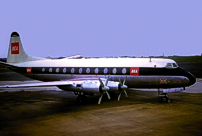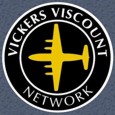
November 1953 to December 1963
British European Airways Corporation (BEA)
G-AMOJ - c/n 23 - a V.701 series Viscount
United Kingdom registered
9 November 1953
Registered to British European Airways Corporation (BEA), Keyline House, Ruislip, Middlesex.
25 November 1953
Certificate of Airworthiness issued.
30 November 1953
Delivered to British European Airways (BEA) named as 'R M A Sir James Ross'.
It was fitted with Rolls-Royce Dart RDa3 Mark 505 engines.
The cabin was fitted out with a 47 seat all-tourist class layout.
14 September 1954
During a flight from London Airport (Heathrow), Middlesex, England to Schiphol Airport, Amsterdam, Netherlands a near miss (within 100 metres) was reported with a Royal Netherlands Air Force Gloster Meteor at Harderwjik, Netherlands.
1954 to 1962
The original ‘cutlass’ design propeller blades were gradually replaced by new symmetrical ‘needle’ blade propeller sets.
From photographic evidence, both propeller types were fitted to Rolls-Royce Dart RDa3, Mark 505 and Mark 506 engines and many aircraft flew with an ‘intermix’ of both types of propeller blades.
14 February 1955
This aircraft was used to fly HRH Princess Alexandra from Portela Airport, Lisbon, Portugal to London Airport (Heathrow), Middlesex, England.
May 1955 to December 1956
All BEA Type 701 aircraft were gradually retrofitted with Rolls-Royce Dart RDa3 Mark 506 engines which were upgraded using modified Mark 505 engines.
Aircraft are known to have flown with an ‘intermix’ of both engine marks between these dates.
When completely retro-fitted with Mark 506 engines, the Type 701A designation was applied to these aircraft although this has not been seen widely used or quoted.
9 December 1958
Noted at Gatwick Airport, Surrey, England carrying out ILS approaches and overshoots.
10 December 1958
Noted at Gatwick Airport, Surrey, England carrying out ILS approaches and overshoots.
13 December 1958
Noted at Blackbushe Airport, Hampshire, England carrying out ILS approaches and overshoots.
24 December 1958
Noted at Gatwick Airport, Surrey, England due to a London Airport (Heathrow) weather diversion.
18 February 1959
Noted at Gatwick Airport, Surrey, England due to a London Airport (Heathrow) weather diversion.
March 1959
A new BEA 'Red Square' livery was adopted and aircraft were repainted during the early 1960s when they next went in for overhaul.
Sadly, after repainting, the aircraft no longer carried a name including the nameplate on the forward cabin bulkhead.

BEA
‘Red Square‘ livery
31 March 1959
BEA annual report quotes a total flying time of 10,498 hours.
13 April 1959
Noted at Gatwick Airport, Surrey, England carrying out multiple ILS approaches and overshoots.
May 1959 to May 1960
Converted from 40/47 seats to 60/63 seats in a new high density configuration. This modification also entailed the installation of an 11th standard size window on the rear starboard side and a small window behind the rear entrance door on the port side.
9 June 1959
Noted at London Airport (Heathrow), Middlesex, England operating a service to Portela Airport, Lisbon, Portugal on behalf of Transportes Aéreos Portugueses (TAP).
This happened on a regular basis with various BEA Type 700 and Type 800 Viscount aircraft
A 'TAP' decal was applied to the forward fuselage, near the door whenever the service was operated.
31 March 1961
BEA annual report quotes a total flying time of 14,895 hours. This was highest hours for a BEA Viscount at that time.
31 March 1963
BEA annual report quotes a total flying time of 17,440 hours. Again, this was highest hours for a BEA Viscount at that time.
6 December 1963
Sold to Tradair Ltd for use by Channel Airways.
Total flying time with BEA - 17,446 hours.
By March 1964 at the retirement of the Type 701 fleet this was the most utilised BEA Viscount of all three fleets - Type 701, 802 and 806.
 FURTHER READING: Books about BEA - British European Airways FURTHER READING: Books about BEA - British European Airways
|



